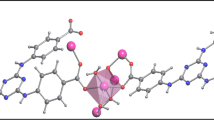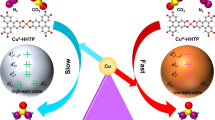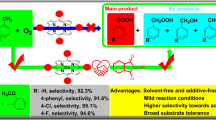Abstract
Both compounds of CuBr⋅C6H4N3(OC3H5) (sp. gr. P1, a = 7.633(1) Å, b = 9.987(1) Å, c = 14.898(2) Å, α = 104.75(1)∘, β = 94.76(1)∘, γ = 106.90(1)∘) (I) and 2CuCl⋅C6H4N3(OC3H5) (sp. gr. Cc, a = 11.2483(4) Å, b = 16.7076(6) Å, c = 7.2948(3) Å, β = 118.612(2)∘) (II) composition were prepared by alternating-current electrochemical synthesis. In I due to a bridging function of organic moieties 16-membered cycles appear which are combined into ribbons {Cu2Br2[(C6H4N3(OC3H5)]2} n . Each of two crystallographically independent copper atom possesses a trigonal-pyramidal arrangement with different degree of tetrahedral distortion. Distinctive numbers of hydrogen bonds around Br1 and Br2 atoms cause rather appreciable distinctions in copper–olefinic bond interaction effectiveness for each metal atom. In II Cu2Cl2 rhombs are joined to infinite chains oriented along [010] direction. Each ligand molecule is also coordinated through the C=C—bond of the allylic group to copper atom of one inorganic chain and through the nitrogen atom to a metal atom belonging to another copper-halide chain. Cu1 atoms is tetrahedrally surrounded by three chlorine atoms and nitrogen one, whereas a trigonal-planar arrangement of Cu2 atom is formed by two halogen atoms and slightly disordered olefinic group.
Similar content being viewed by others
References
Goreshnik, E.A. Polish J. Chem. 1999, 73, 1253.
Goreshnik, E.A.; Pavlyuk, A.V.; Schollmeyer, D.; Mys’kiv, M.G. Rus. J. Coord. Chem. 1999, 25, 653.
Goreshnik, E.A.; Davydov, V.N.; Pavl’uk A.V.; Mys’kiv M.G. Rus. J. Coord. Chem. 1999, 25, 732.
Goreshnik, E.A.; Schollmeyer, D.; Mys’kiv, M.G.; Pavl’uk O.V. Z. Anorg. Allg. Chem. 2000, 626, 1016.
Goreshnik, E.A.; Schollmeyer, D.; Mys’kiv M.G. Z. Anorg. Allg. Chem. 2002, 628, 2118.
Manacham, S.E. Inorg. Chem. 1966, 5, 2063.
Mykhalichko, B.M.; Mys’kiv M.G. Ukraine Patent UA 25450A, Bull. 1998, N. 6.
Altomare, A.; Cascarano, G.; Giacovazzo, C.; Guagliardi, A.; Burla, M.C.; Polidori, G.; Camalli, M. SIR-92—a program for automatic solution of crystal structures by direct methods. J. Appl. Cryst. 1994, 27, 435.
Sheldrick, G.M. SHELXS97 and SHELXL97. Programs for the solution and refinement of crystal structures. Göttingen University, Germany, 1997.
Akselrud, L.G.; Gryn, Yu.M.; Pecharsky, V.K.; Zavalij, P. Yu.; Baumgartner, B.E.; Wolfel, E. Proc. Sec. Eur. Powder Diffraction Conf., Enschede, The Netherlands, 1992.
Bergerhoff, G.D. Visual Crystal Structure Information System; University Bonn: Germany, 1996.
Brammer, L.; Bruton, E.A.; Swearingen, J.K.; Sherwood, P.; Purver, S.L.; Adams H. Acta Cryst. 2002(Supplement), A58, C226.
Mys’kiv, M.G.; Olijnyk V.V. Rus. J. Coord. Chem. 1995, 21, 275.
Author information
Authors and Affiliations
Corresponding author
Rights and permissions
About this article
Cite this article
Goreshnik, E.A., Schollmeyer, D. & Mys’kiv, M.G. Synthesis and crystal structures of two copper(I) π-complexes with 1-allyloxybenzotriazole of CuBr⋅C6H4N3(OC3H5) and 2CuCl⋅C6H4N3(OC3H5) compositions. J Chem Crystallogr 35, 565–571 (2005). https://doi.org/10.1007/s10870-005-5385-4
Received:
Issue Date:
DOI: https://doi.org/10.1007/s10870-005-5385-4




